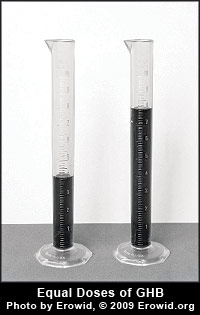Psychoactives 101:
GHB Concentration and Dosage
v1.0 - Nov 2009
Citation: Erowid Crew. "Psychoactives 101: GHB Concentration and Dosage." Erowid Extracts. Nov 2009;17:21.
| What's Your Dose? |
|
Ryan: "I usually take 8 ml of GHB." Amy: "Yeah? My normal dose is 8 ml, too." By stating their dosages precisely, it seems like these two people are communicating clearly. But does Amy prefer the same dose of GHB as Ryan? There's no way to know. Describing dosage in milliliters, a volumetric measurement, doesn't tell us how much GHB they are taking. Ryan and Amy can only accurately compare their doses if they know the exact concentrations of GHB in their materials, which are unlikely to be the same unless they came from the same batch from the same source. Ryan's material could be 0.5 g/ml, so his 8 ml of liquid would contain 4 grams of GHB, which is a high recreational dose. Amy's material could be 0.25 g/ml (half the concentration of Ryan's), which would mean that her 8 ml of liquid contains only 2 grams of GHB, a more common dose. If Amy used Ryan's GHB instead of her own, her normal 8 ml dose would contain twice as much GHB as she is used to, possibly leading to an unpleasantly strong overdose. A safer method would be for Amy to take what Ryan considers to be a low dose of his material, regardless of what her normal milliliter dose is, so that she can test her response. If the starting dose turns out to be lower than she would like, an additional dose could be ingested after two hours. 
|
Volume vs. Mass
If a person doesn't know their preferred dose of GHB as measured in grams of pure powder (mass), but instead knows only their liquid dose measured in milliliters, capfuls, or teaspoons (volume), then they don't actually know how much GHB they take. Because street GHB in liquid form does not come in a standard concentration, volume is not an accurate description of dose."Liquid GHB"
GHB is a hygroscopic powder at room temperature; unless kept very dry, it will attract water out of the air and become goo or a thick liquid. Most underground chemists prefer to create a product that is a solution of GHB in water, both because the synthesis is simpler and because it avoids the problem of keeping the material dry. This is often referred to as "liquid GHB".The more GHB there is in a given amount of water, the higher the concentration, and the thicker the solution. At around 0.7-1.0 gram of GHB per milliliter of water (g/ml), the solution becomes quite viscous, and may even begin to crystallize. Yet at low concentrations, the solution is visually indistinguishable from water.
Some people mix their own solutions and therefore know the concentration of their material; most people buy from a supplier who may or may not know the concentration.
Concentration is Key
It is critical that those working with GHB know that concentrations of different batches can be quite different, resulting in very different volumes that contain a given dose. Because of this, users should treat all new batches of liquid GHB as if they are of unknown strength. They should either find out what the concentration of the material is (how many grams per milliliter) so that they can calculate their own milliliter dose based on their preferred dose in grams, or they should ask what a low starting dose is for the material in milliliters and be very conservative about how much they take until they are familiar with the material.Overdose Risks
Overdosing is a real risk with GHB as well as with related substances such as GBL and 1,4-butanediol. Symptoms can range from rapidly falling into an unrousable sleep, to dizziness, nausea, and/or vomiting, which is potentially fatal in an unconscious person. Momentary lapses in breathing are also possible at excessive doses and are increasingly likely if other CNS depressants have been consumed or if the user suffers from sleep apnea.Even those experienced with GHB can make dangerous errors due to incorrect assumptions about the concentration of materials from different sources.


